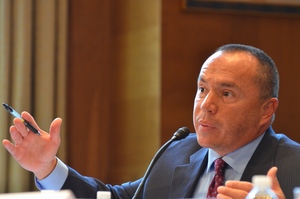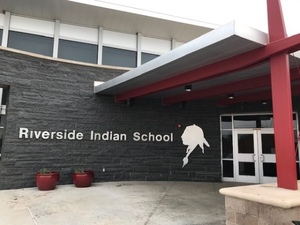Tony Dearman is the longest serving Director of the Bureau of Indian Education, an agency within the federal government’s Department of the Interior. The Bureau supports 183 schools serving Native American and Alaska Native students across the United States.
Bringing Stability to the Bureau
When Tony Dearman became Director of the Bureau of Indian Education in 2016, he had been preceded by 37 directors in 35 years. Dearman has since reversed this trend, becoming the agency’s longest-serving director. He heads a team that funds 183 schools on 64 reservations in 23 states (128 are tribally controlled schools while 55 schools are directly operated by the Bureau itself). Over 200 of 574 tribes in the United States are represented in the Bureau’s portfolio of schools. Many are located in remote rural areas.
Dearman’s role is also somewhat unique in public education. Bureau schools are mostly federally funded through Congress. In 2022, Congress appropriated 1.3 billion dollars to the Bureau for its 183 schools. The only other federally operated public schools are those that the Department of Defense runs. But unlike Department of Defense schools, tribally controlled schools retain considerable operational autonomy. This autonomy is enshrined in federal legislation. In 1975, the US Congress adopted the Indian Self-Determination and Education Assistance Act, which transferred greater governing authority to individual tribes for managing federally-administered programs and services, including Bureau-funded schools.
Dearman, in part, credits his longevity as Director of the Bureau to respecting tribal authority. He and his staff regularly hold listening sessions with tribal leaders where he can elicit tribal input and build trust. He acknowledges that it can be a difficult balancing act. The Bureau must find ways of creating federal policy for schools serving tribes of different customs, ancestral languages, and interests.
But Dearman, a member of the Cherokee tribe, has experienced firsthand how Bureau policies work on the ground. He grew up in Bunch, Oklahoma – a town of 70 residents on the western edge of the Ozark Mountains. After completing a degree in Science Education, he went on to become a science teacher (and eventually principal) at Sequoyah High School – a Bureau of Indian Education-funded residential school that sits on 90 acres in the northeastern corner of Oklahoma. In 2010, Dearman was tapped to serve as Superintendent of Riverside Indian School in Anadarko, Oklahoma. Riverside is a nationally renowned Bureau-operated residential school that is home to 800 students who come to the school from 75 tribes throughout the United States. In 2015, Dearman became Deputy Director for the Bureau before stepping into the role of Director the following year.
Native American Students and Bureau-funded Schools
Dearman estimates that 7-10% of the United States’ Native American students attend Bureau-funded schools. In the United States, there are over a half-million Native American students, which is approximately 1% of all US students. High-quality research on the performance of Native American students is surprisingly limited. Even large national datasets contain only small samples of Native American students. For statistical research, researchers often resort to excluding Native American students or combining them with other racial groups. As a result, Native American student performance ends up concealed in quantitative analyses.
Oklahoma has the largest number of Native American students of any US state, being the primary site for the federally led relocation of tribes during the early and mid-1800s. Over 130,000 Native American students attend Oklahoma’s public schools. This number is double that of Arizona’s, which has the second highest number of Native American students. About 8% of Oklahoma’s Native American students attend Bureau-funded schools that offer tribal language and history classes, tribal arts and music, and school activities honoring tribal customs. To attend Bureau-funded schools, students must either be members of a federally recognized tribe or be at least one-fourth Native American.
Changing Perceptions of Residential Schools
Today Bureau-funded residential schools are increasing in popularity. Some even have a waiting list for admission. Yet, scholars contend that residential schools have a grim past that make Native American communities suspicious of them to this day. Residential schools for Native Americans were founded with the goal of assimilating Native American children into mainstream American culture – in some cases, by forcibly removing them from their families. Because federal residential schools were part of this cultural assimilation policy, they still signify cultural suppression for some Native Americans.
According to Dearman, however, residential schools are not what they once were. For example, Riverside Indian School in Anadarko draws students from tribes across the United States. Dearman says that graduates of Riverside often return home to serve in leadership roles in their tribal communities. He hopes to continue to shift perceptions of Bureau-funded residential schools.
Performance and Accountability Amid Self-Determination
Congress is starting to call for hard data and accountability for performance from Bureau-funded schools. Dearman, too, wants quality data but admits that the Bureau has struggled to assess school performance in the past. Dearman argues that every leader of any school is going to want more funding, so he wants to promote Bureau-funded schools by demonstrating success with performance data.
To improve performance metrics, Dearman recently led the creation of his agency’s first common standards, assessment, and accountability system. Previously, Bureau officials would examine how students did on assessments in the states where they were located. But state assessments differ, making it difficult to compare students who attend schools in different states. The Bureau’s new unified system allows for achievement comparisons across US states. Dearman is quick to point out that the tribes are ultimately in control and can opt out of the system if they wish. Many have opted to participate. School leaders continue to debate how accountability should be done and if such systems can truly demonstrate school performance. Only time will tell if Dearman’s unified accountability system will become a meaningful marker of success for Bureau-funded schools.
Author Bio
Daniel Hamlin is Professor of Education Policy and Research Director of the Leadership and Policy Center for Thriving Schools and Communities (THRIVE) at the University of Oklahoma.






